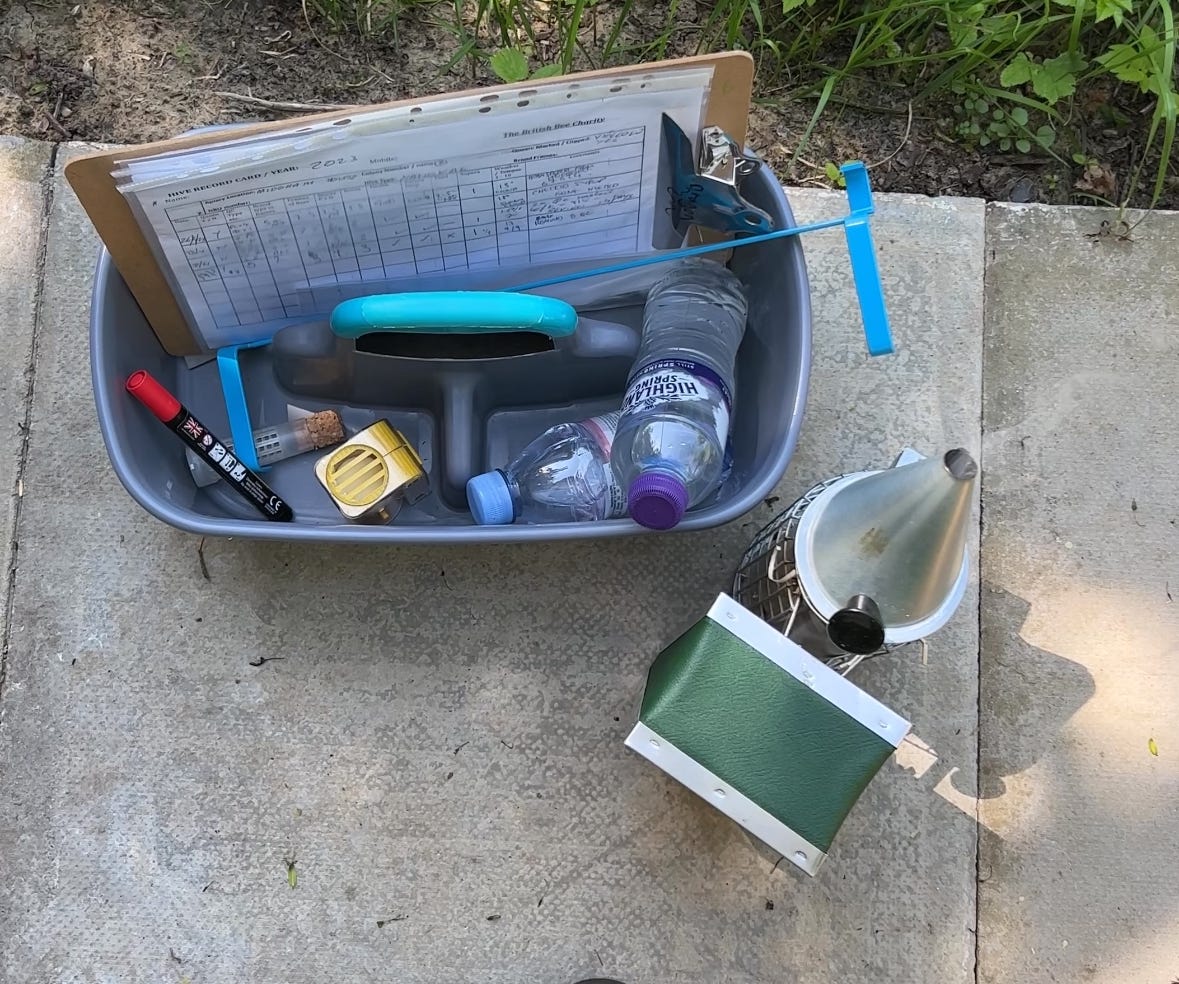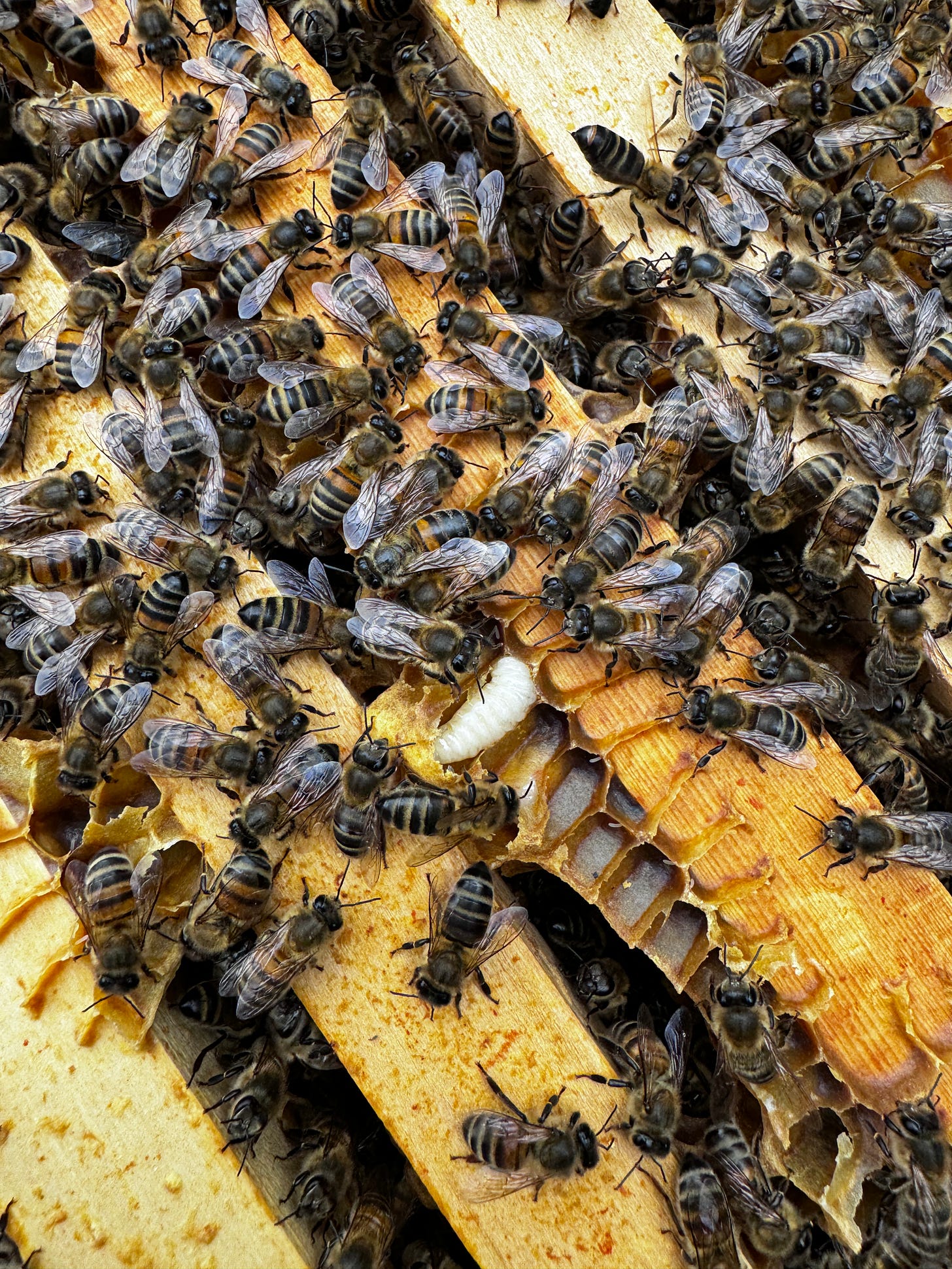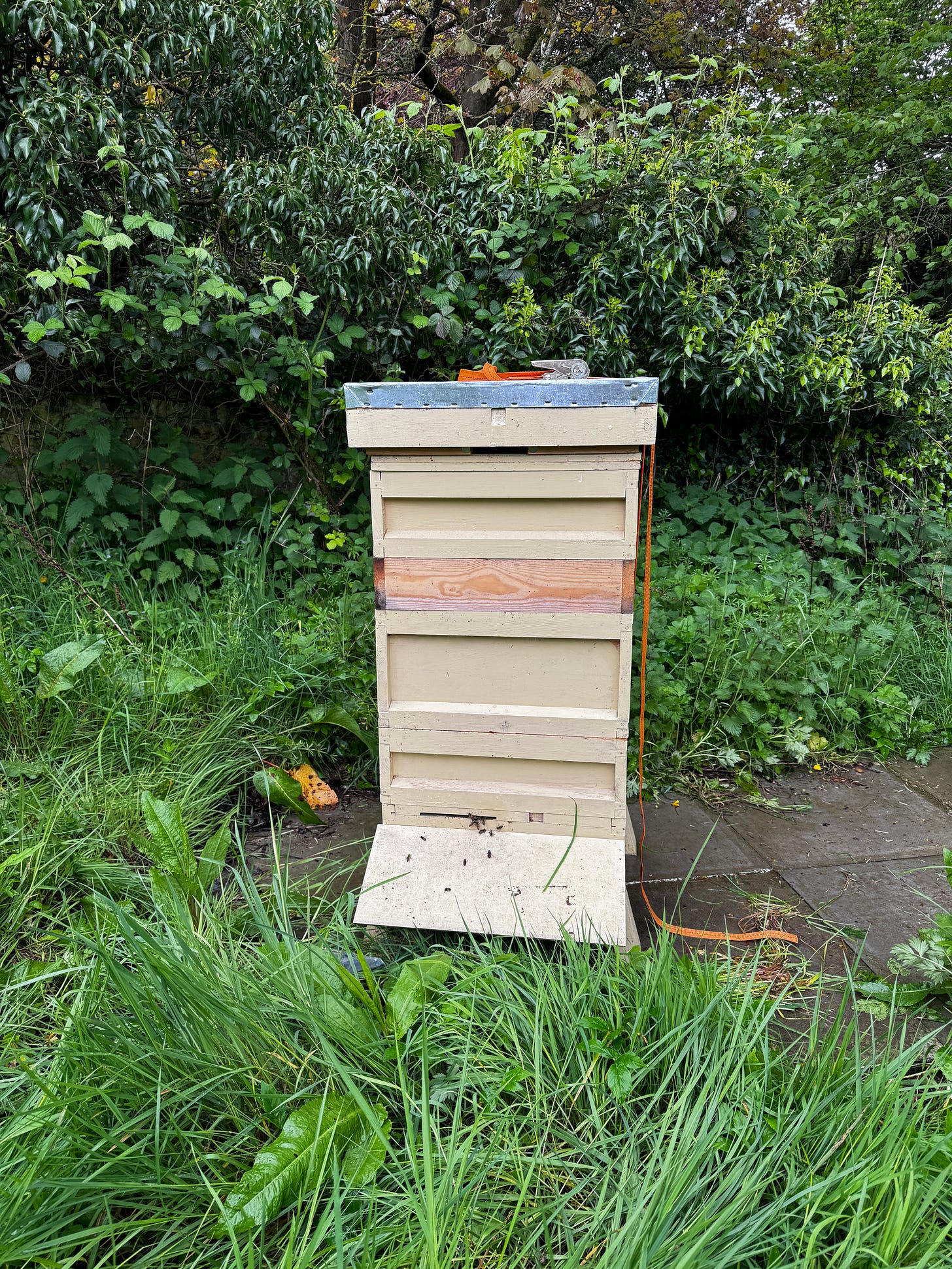I have missed writing my second weekly piece for you for quite a while now, so as promised earlier this week, an additional piece.
As you know, on the farm where I work we keep bees. I have been a guardian of two colonies for the last year, one hive sadly didn’t survive the cold of last winter. The other was today, ready to be opened again for the first time since the end of autumn last year.
Take advantage of a half-price discount that is valid throughout May, on all new yearly subscriptions. If you were to upgrade, you’d be supporting my writing, making everyone a winner in my opinion
A damp afternoon on the farm
Berkshire, May 2024
I needed to take one of the cedar boxes of frames down from the shelf in the storeroom,. A wooden box that’s called a ‘super’ in beekeeping terms, but if I told you off the bat that I needed to grab a super, then you’d likely be wondering what on earth I was talking about.
But now you know.
It’s a square wooden box with no top or bottom, just a square really, that you slot little wooden boards filled with wax foundation for bees to build into the little hexagonal chambers that they fill up with stores of honey. Or perhaps an unruly Queen might decide to lay eggs there, when she should know better, just to confuse matters when it comes to hive management and to make my work that little bit more edgy.
I slide the heavy wooden pieces from above my head, a dusting of dry wax crumbles as the frames rub against each other, falling like stardust onto me as I lift it down, remnants from the old hive that didn’t make it through last winter. I’d frozen the frames for a week in the deep freeze to ensure that any bugs would be taken care of, and so today I can re-use it for our stronger colony that has likely run out of space.
An extension to their home as it were
For a moment I felt sad for the bees that had made those little wax cells, those little bees that didn’t have the numbers to fight against the cold that came in January. I had de-assembled that hive one grey afternoon alone, sweeping out the last of the bees that lay quiet on the bottom of their home. I had a knot in my stomach as I worked my way through. There weren’t many. A strong colony would have at the height of summer about sixty thousand bees, and over winter it could be half that amount, busy keeping their Queen warm. The reality was that when I swept the bottom board into the long grass in front of the hive there was no more than five hundred at most. A beehive that had many issues over that year, but we were confident that it had the strength to survive the winter.
Our confidence was misjudged.
Hive one and hive two. That is what I always called them. Now we only have hive one to check. Hive two will be reborn with a new queen and a new nucleus of bees when the weather remains calm, though with the forecast for this little corner of England once again showing rain, I must wait.
It’s official
I received a notification from The National Bee Unit, an official-looking email in the Government’s font. One to certainly draw your attention.
It announced that as the weather has been so terrible in Southern England that there is a risk of starvation for honeybee colonies, as the pollen and nectar that is early foraging for bees to convert to food for young bees or for stores to seal into honeycomb for later in the year, had been ruined as the rain had smashed all of the delicate blossom flowers.
I was duly notified that I must feed my bees.
With rain and wind forecast for the whole of the week, I took what was to be the only chance I had, to once again don my bee suit and light a plug of dry straw, wood chippings and old leaves rolled in my hand to a smouldering ball, to be pushed into the hive smoking tool, snapping the lid firmly shut and squeezing the leather bellows on its side, to coax the smoke into life, a thick slow steel grey plume that rises from what looks like the spout of a metal teapot.
Now ideally I should wait for a day when the sun is warm and the temperature holds above the chill of an English spring day, but in this case, a damp afternoon in between breaks in the rain will have to do. The chance that these creatures (who in essence are wild, but helped by us with essentials to ensure that they have the best chance of survival) might starve is something I can not think of.
The loss of one colony still troubles my heart.
Aaron accompanies me to help lift the heavy sticky frames that have likely become stuck fast over winter, glued together with propolis, gummy to the touch, a sweet glue that holds everything fast. It’s a job for two people and as I’m unsure what to expect as they haven’t been opened for nearly six months I’ll be glad to have someone with me. We step into our suits, Aaron says he “loves an outfit”, but then he’s a photographer who shoots covers for Vogue so I get where he’s coming from. We zip up our oversized cotton overalls, with hand loops and toggles that cover any potential places a bee might find a way in, and the familiar beekeeper’s veil gets zipped up over our heads. We check each other to ensure we are bee-proof.
In autumn last year and when feeding the bees blocks of fondant over winter, I often would take the roof off to replace the feeders without wearing a bee suit, trusting that as they were busy inside the hive and would probably not be overly threatened, then I could perform small tasks quickly and efficiently without protection. Quicker that way.
I was only stung once last year, I was fully suited and gloved, even wearing Wellington boots on a hot summer’s afternoon, and that was entirely my own fault for not looking where I put my fingers when I lifted a frame up and out, taking for granted that I had a clear place to hold the small wooden lugs on the sides of the piece.
I got stung on my little finger.
And usually when you get stung it’s largely your own fault. Bees don’t want to sting you at all. Only if you make them angry, prod at them or make a loud noise will they feel threatened enough to attack you, or if you put your hand down without looking.
Opening the hive
I approach the hive from the side, never in front of the flight path. I puff some smoke into the hole of their little doorway, a thin wooden block with a small horizontal gap chiselled out of it. The bees scurry back inside as I hoped. Moving to the back, away from the door, I push the edge of the thin metal hive tool I carry between the sections of the brood box and the super beneath it. Pushing in the corner and twisting upwards to prize apart the levels. It frees itself more easily than I had thought it would, so once again I take the smoker and with a soft squeeze, give it a few gentle puffs, letting the steel grey ribbons plume upwards with that oh-so-captivating smell of burnt wood. I then place the tip of the spout next to the thin crack that I’ve opened. I squeeze a few more puffs into the chamber of the hive, before letting everything settle for a minute.
Smoke doesn’t make bees sleepy. That is a misconception.
What it does is trigger a response that is wired into their ancestory as wild creatures, that tells them that potentially the forest is on fire, so they must gorge themselves on their stores to prepare to fly. This way the bees will ready themselves by quietly filling themselves with honey in preparation to swarm.
This is also why smoke must only be used sparingly.
One other good reason for a little smoke is that when bees have a full tummy, they find it more difficult the curve their tails to sting you, much like you or I might find ourselves if we’d eaten far too much lunch.
One or two scouts might be sent out when you first unlock the ratchet strap that keeps the hive tightly fastened together. As you squeeze the clip together and pull the lever backwards, it makes a loud metallic ‘pop’ that echoes in the empty roof.
I’m sure they don’t like that. Thousands of bees sat busily in the dark, minding their own business.
Then, Pop.
And the roof comes off.
There is always one that will fly out of the entrance, aggressively buzz at your veil, or close by your ear, testing your unflappability. Sent by the hive’s bidding to test us.
Lifting off the top level I am looking at what is most easily described as a metal grid, just wide enough to prevent the large queen from escaping. This top level is clustered with honeybees, larvae in cells, eggs, drones and burr comb. It has everything. I puff a couple more clouds of smoke to send them all down inside the hive, before removing the grid, and placing it on the entrance ramp so the few bees that refused to come can walk back into the door. The hive is now open, and for the moment the weather stays fair. I lift out one frame, heavy with bees, the girls that have hatched from the eggs laid before winter who will fill this hive with nectar as the spring flowers and tree pollen come in abundance. Carefully I place it snugly back against the next, I don’t take out more than one. Today is not the day. The day for a full hive inspection can wait for a week or two, when the sun is shining and there is no dampness in the air.
I place a plastic feeder on top of the frames, so the bees are free to drink as much syrup as they need to ensure against starvation. They may not need it, as the honey stores I see are heavy, but as the email written in official font tells me to, so I feed them. I built the hive back around the feeder and placed on top the box I brought down from the shelf in the storeroom. The box with the frames that had sustained hive two for the best part of a year, now giving these girls more space to be bees.
I close them in, securing the crown board and roof, then ratchet the bright orange strap so it is back at full tension, and then we walk away.
As I tidy up, I open the smoker and tip out the last of the blackened ashes onto the damp grass, and with the heel of my shoe, scuff it into the earth.
With the last of the tools back in the caddy, I idly pick up an empty packet of fondant that I removed from the top of the hive and put in with the bits and pieces to take back up to the house. I nearly get stung in the process as there are about fifty bees still clustered inside it, licking the last drops of sweetness from inside.
And then comes me with my clumsy fingers.
Nearly.
Until next time
William







Fascinating insights, Will. I think I held my breath while reading that. ‘Guardian of the Bees’ is the perfect way to view the relationship. Lovely words. Thank you.
I feel good that someone of your character is investing time and resources to care for the bees in your part of the world...